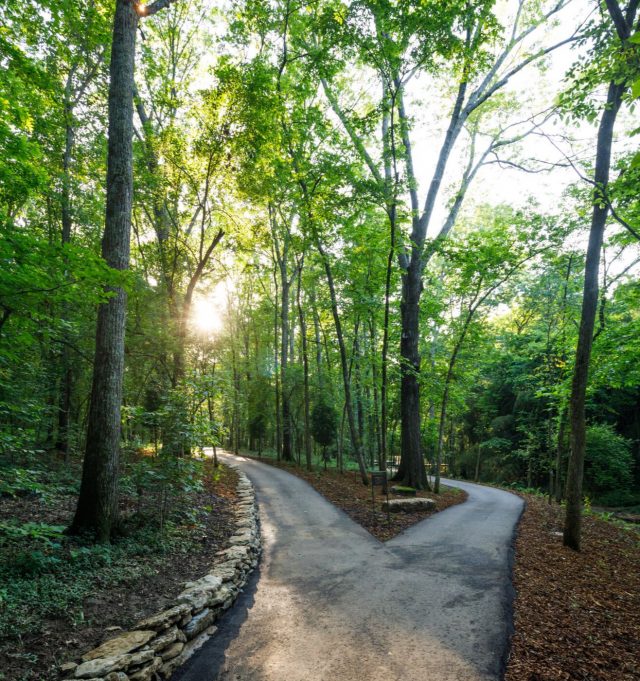About the Gardens

The Ann & Monroe Carell Jr. Family Sculpture Trail
Established in 1999 through the generosity of Ann and Monroe Carell Jr., and features thirteen works on a 1.5-mile woodland path, a setting not commonly found at museums or sculpture parks in the United States. Though modelled after venues for outdoor sculpture in England like the Forest of Dean Sculpture Trail and the Yorkshire Sculpture Park, from the very beginning the intention was to exhibit artwork that responded to Cheekwood’s distinctive natural setting. The sculptures along The Carell Trail each examine the relationship between art and nature in their own distinct way, creating beautiful, thoughtful dialogues with the surrounding landscape.

About Walk Four
Walk Four, acceptance, is often a difficult state-of-mind to come to, but achieving it teaches you to endure and overcome many negative experiences in life, resulting in better psychological health.1 This walk is best suited when you feel like a situation was unfair or you are unable to change what has happened.
Remember to allow yourself at least 10 minutes at the beginning of each walk to become present physically, and mentally. One way to do this is by practicing the steps outlined in Walk One, Two, and Three. Consider the sights, sounds, textures, and scents around you. Be curious by slowing down, wondering, seeking answers, and speaking less. Open yourself up by recognizing, allowing, investigating and non-identifying with your emotions.
The Ann & Monroe Carell Jr. Family Sculpture Trail can be found by continuing past Botanic Hall, through the Bradford Robertson Color Garden and arches, and across the roundabout. The entrance to the Sculpture Trail is indicated by a stone gate at the bottom of the path. Go through the gate and keep to the left-most path to find The Glass Bridge (Siah Arjamani, 2003). Each stop on Walk Four is marked by a purple circle along the path.
Before you begin:
Stand still and take a deep breath. In and out.
Take note of how your body is feeling.
As you walk:
Bring attention to the movements and sensations in your body. Notice how your hips and shoulders move, your steps firm on the ground, how your chest rises and falls with each breath, gently and assuredly.
Prompts
Each stop on Walk Four is marked by a purple circle along the path.
Stop One: Recognize
Once you have made your way through The Glass Bridge (Siah Arjamani, 2003), allow yourself to recognize any tension you are experiencing. Do the feelings go beyond your mindset? Is there any pain physically or spiritually? Write down the specific areas where you feel strained. Be intentional about simply noticing these things, not spiraling into them. Let your physical steps keep your thoughts moving and continue on your journey.
Stop Two can be found by continuing in the same direction on the path and venturing onto the boardwalk.
Stop Two: Realize
At the Crawling Lady Hare (Sophie Ryder, 1997), observe that your emotions are fighting against reality, yet these emotions are very normal and often shared by those in similar circumstances. Remind yourself that, even though it’s unpleasant, there are things that you can’t change. What exactly is outside of your control? Think large and small. Other’s actions or emotions, the seasons and weather, the stock market? Realize that you can only do what you can do. Let your physical steps keep your thoughts moving and continue on your journey.
Instead of continuing straight back to the gate, follow the branch of path towards the Mansion. Stop Three is found by continuing on the left-most path.
Stop Three: Reflect
When you’ve found yourself at Ulrich Ruckriem’s, Untitled (1993), consider what you know of the situation. Give yourself time to explore until you can identify each element: who is involved, what is the topic, when did it happen, how does it make you feel, and why do you think it happened. Have you experienced something like this before? Has anyone else? What would your behavior look like if you did accept things as they are? If you continue to give into the negative emotions, what might your future look like? Let your physical steps keep your thoughts moving and continue on your journey.
Stop Four is found by continuing past Ruckriem’s sculpture and turning to the right when the trail splits. Follow this path until you reach the cylindrical structure of James Turrell’s sculpture.
Stop Four: Release
Finally, spend some time cradled inside the Blue Pesher (James Turrell, 1997-1998). Sit firmly and comfortably. Make every effort to release the tension you feel. Deeply breathe in… and out… lower your shoulders, unclench your jaw and your fists. Acceptance is multi-faceted and does not mean “giving up.” It is the acknowledgment of facts, what has been, and can be, done. Not wishing something would have been done. Look up, through the opening in the ceiling. Let go of what you cannot change.
Take three deep breaths. Each one deeper than the last.
Sit in gratitude, forgiveness, and assurance.
Think on these things as you reach the end of Walk Four.
“I can alter my life by altering my attitude. He who would have nothing to do with throws must never attempt to gather flowers.”
– Henry David Thoreau
Further Reading:
On Openness:
“How to Use the RAIN Method for Difficult Emotions” via Harmony Behavioral Health Blog
“5 Key Emotional Intelligence Skills,” by Kendra Cherry via verywellmind.com
On Acceptance:
“Accepting Reality,” by Mental Health America. Via mhanational.org
“Accepting Reality Using Dialectical Behavior Therapy (DBT) Skills” via skylandtrail.org
